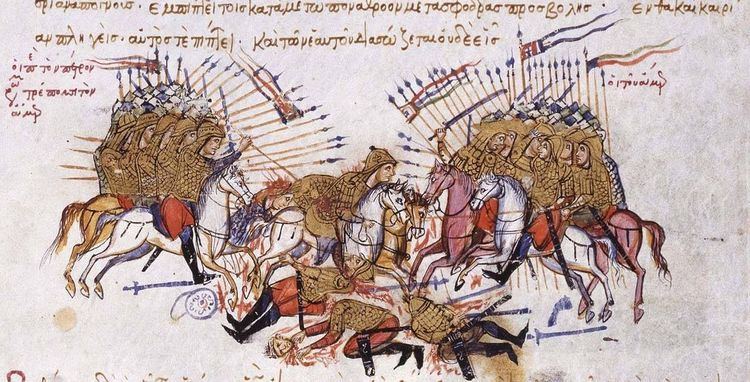 | ||
Stratopedarchēs (Greek: στρατοπεδάρχης, "master of the camp"), sometimes Anglicized as Stratopedarch, was a Greek term used with regard to high-ranking military commanders from the 1st century BC on, becoming a proper office in the 10th-century Byzantine Empire. It continued to be employed as a designation, and a proper title, of commanders-in-chief until the 13th century, when the title of megas stratopedarchēs (μέγας στρατοπεδάρχης) or Grand Stratopedarch appeared. This title was awarded to senior commanders and officials, while the ordinary stratopedarchai were henceforth low-ranking military officials.
Contents
Origin of the term and use in the early Byzantine period
The term first appears in the late 1st century BC in the Hellenistic Near East. Its origin is unclear, but it is used as a translation, in some inscriptions, for the contemporary Roman legionary post of praefectus castrorum ("camp prefect"). Josephus (De Bello Judaico, VI.238) uses the term to refer to the quartermaster-general of all camps, while Dionysius of Halicarnassus (Roman Antiquities, X.36.6) used it to refer to the role of a primus pilus in a legion that had lost its commander. It also occurs in the Bible (Acts 28:16), where it has been interpreted as referring to the praetorian prefect, the commander of the camp and garrison of the Praetorian Guard in Rome, or the subordinate officials praefectus peregrinorum and princeps castrorum.
From the 1st century AD, it was used (albeit infrequently) in a broader sense as a literary term to refer to generals, i.e. as a synonym of the older title stratēgos. Thus in the 4th century, the bishop and historian Eusebius (Church History, IX.5.2) writes of the "stratopedarchēs, whom the Romans call dux". Similarly, in the early 5th century, Ardabur was called "stratopedarchēs of both forces" by Olympiodorus of Thebes, while the acts of the Council of Chalcedon (451) refer to Zeno, "patrikios and stratopedarchēs of both forces of the East". This is an obvious translation of the Latin term magister utriusque militiae, especially as the contemporary historian Eunapius records that the stratopedarchēs was "the greatest of offices". Other Greek-language authors translate Ardabur's title more commonly with stratēlatēs or stratēgos. The German historian Albert Vogt suggested that the stratopedarchai were military intendants, responsible for army supplies and managing the fortified assembly bases, the mitata.
However, as the Byzantinist Rodolphe Guilland commented, references to a stratopedarchēs are rare before the 10th century, and always seem to be a different way of referring—often anachronistically—to a magister militum, or later a thematic stratēgos. Such references exist to emperor Jovian (r. 363–364), who was a general before his rise to the throne, by Theophanes the Confessor; Rusticius, a general of Leo I (r. 457–474), by Zonaras; Busur, an Arab commander in c. 650, by Theophanes; Krateros, a "stratopedarchēs of the East" who was sent to arrest Theodore Stoudites; Eudokimos, stratopedarchēs/stratēgos of Cappadocia and Charsianon under Theophilos (r. 829–842); and a certain Mousilikes, subordinate of the thematic stratēgos of Sicily. A prōtospatharios Constantine, whose seal mentions him as a stratopedarchēs, can not be further identified.
Middle Byzantine period
In the middle Byzantine period (9th–12th centuries), the term stratopedon came to signify more the army on campaign, rather than the camp itself; hence the term stratopedarchēs was used more in the sense of "commander-in-chief". The term acquired a technical meaning in 967, when Emperor Nikephoros II Phokas (r. 963–969) named the eunuch Peter as stratopedarchēs before sending him with an army to Cilicia. The Escorial Taktikon, written a few years later, shows the existence of two stratopedarchai, one of the East (Anatolia) and one of the West (the Balkans). This arrangement parallels that of the two domestikoi tōn scholōn, a fact that led Nicolas Oikonomides to suggest that the post was created as a substitute of the latter office, which was barred to eunuchs.
During the 11th and 12th centuries, this precise arrangement is no longer in evidence; instead, stratopedarchēs was one of the official titles of the commanders-in-chief of the Byzantine army, and is amply attested in seals.
Late Byzantine period
The title megas stratopedarchēs ("grand master of the camp") was instituted c. 1255 by the Emperor Theodore II Laskaris (r. 1254–1258) for his chief minister and confidante, George Mouzalon. Theodore II states in a decree that he "established the dignity anew", but no other holder of the office is known before that time. The mid-14th century Book of Offices of pseudo-Kodinos places the megas stratopedarchēs as the ninth-most senior official of the state below the Emperor, ranking between the prōtostratōr and the megas primmikērios. Kodinos reports that he was "supervisor of the provisioning of the army, that is food, drink and all necessities". In reality, however, during the Palaiologan period (1261–1453) the [megas] stratopedarchēs was most likely an honorific court title, and did not necessarily entail an active military command. Like many other titles in the Palaiologan period, the post could be held by two people simultaneously. According to Pseudo-Kodinos, the ceremonial costume of the megas stratopedarchēs was identical to the offices immediately superior to it: a rich silk kabbadion tunic, a golden-red skiadion hat decorated with embroideries in the klapōton style, without veil, or a domed skaranikon hat, again in red and gold and decorated with golden wire, with a portrait of the emperor standing in front, and another of him enthroned in the rear. Only his staff of office (dikanikion) differed, with all the knobs except the topmost in silver, and golden engraved knots.
Pseudo-Kodinos further reports the existence of four subordinate stratopedarchai, occupying the 65th to 68th rank in the imperial hierarchy respectively. These were:
The dress of these junior members of the court was the same: a white skiadion with embroideries, a long kabbadion of "commonly used silk", and a skaranikon covered in red velvet and topped by a small red tassel. Their dikanikia were of smooth, unadorned wood.
The semi-autonomous Despotate of the Morea appears to have had a megas stratopedarchēs and subordinate stratopedarchai of its own.
